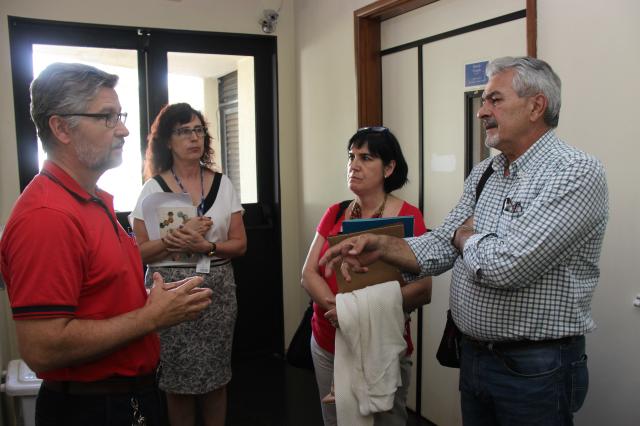Brazil and Argentina strengthen cooperation in agriculture
Brazil and Argentina strengthen cooperation in agriculture
Photo: Claudio Bezerra

From left to right: Maurício Machaim, Marília Burle, Ana Cipolla and Amadeo Nicora
INTA's President visits Embrapa to prospect future research topics of common interest between the countries, with a focus on bioeconomy, among others.
On December 12, 2016, the president of Argentina's National Institute for Agricultural Technology (INTA, from the Spanish acronym), Amadeo Nicora, visited two research units of the Brazilian Agricultural Research Corporation (Embrapa) in Brasília, DF: Embrapa Agroenergy and Embrapa Genetic Resources and Biotechnology. Embrapa and INTA signed a memorandum of understanding in November 2015 and the purpose of Nicora's visit, accompanied by the Institute's deputy director of International Relations, Ana Cipolla, and the agricultural attaché of the Embassy of Argentina in Brazil, Javier Dufourquet, was to learn more about some of the research developed by Embrapa to prospect topics of common interest. On December 13, he is going to meet the president of Embrapa, Maurício Lopes, and the executive directors Ladislau Martin Neto, Vânia Beatriz Rodrigues Castiglioni and Waldyr Stumpf Júnior to argue the operationalization of the technical cooperation projects.
At Embrapa Genetic Resources and Biotechnology, INTA's representatives were welcomed by the head of Research and Development, Marília Burle, and visited the Animal Reproduction Laboratory, where they were received by the researcher Maurício Machaim, and Embrapa's Gene Bank, in which they attended a presentation by the researcher Alexandre Floriani.
At the Animal Reproduction Laboratory, Nicora saw the assisted reproduction biotechniques developed at Embrapa Genetic Resources and Biotechnology, such as IVP (in-vitro embryo production), embryo sexing, in-vitro and in-vivo fertilization, and cloning through nuclear transfer. Brazil is today an absolute leader in IVP in world terms, with about 80% of the global market. Embrapa's research are especially aimed at cattle, but also includes sheep and swine, in partneship with Embrapa Swine and Poulty, in Concórdia, SC.
Cooperation will contribute to agriculture in the Southern Cone
According to Nicora, Brazil has a strategic vision with regard to science and technology, and that is why he deems the cooperation so important for Argentina. "It is fundamental that INTA and Embrapa, as public agricultural research institutions, work sinergistically to take technology to the production sector with speed and efficiency", he pointed out.
For Embrapa's executive director of Technology Transfer, Waldyr Stumpf Júnior, "the visit of INTA's leaders to Embrapa heralds another advance in the institucional ties that have been growing closer for some time. At the moment, the expectation is to proceed to the elaboration of work plans that will provide benefits to scientific and technological cooperation between Brazil and Argentina", he clarifies. "This is a strategic advance, since both countries have important contributions to give to agriculture in the South Cone as members of the PROCISUR (Cooperation Program for Agrifood and Agroindustrial Development in the Southern Cone)", he concludes.
The workplans to be structured after the visit will make the operacionalization of the memorandum of agreement signed last year by Embrapa and INTA possible. The MoU includes, but is not limited to, the following likely areas of interest for the parties: biotechnology, genetic engineering and GMOs, plant and animal genetic resources, animal and breeding and genetic improvement, family farming, production systems, strategic and prospective intelligence, bioeconomics, research and technology transfer for development, machinery for family farming, institutional management and communication for development.
Pioneering animal reproduction technique awakens the interest of INTA's president
The president of INTA expressed a keen interest in the pioneering technique recently launched by the Embrapa Genetic Resources and Biotechnology: intrafollicular immature oocyte transfer (IFIOT). It is a biotechnique that offers all the advantages of the in vitro fertilization (IVF) with a plus: it does not require a lab to be performed. Breeders can obtain the embryos with the same expeditiousness as in IVF, that is, around a calf per week from a single donating cow, without ever having to leave their farms.
The development of IFIOT at Embrapa resulted in the birth of three heifers, which are in the Sucupira Farm, one of the corporation's experimental fields that is also located in Brasília, DF, and in about 50 frozen embryos. Such success had a trademark request be filed at the National Industrial Property Institute (INPI).
At Embrapa's Gene Bank, Nicora learned about research on the conservation of animal genetic resources that focuses on the preservation of animal races that are known as "local" or "naturalized" ones, as they have been found in Brazil for centuries, many since colonial times. Such animals, which include bovines, swine, goats, sheep, asinines, buffalos and horses, are conserved in situ (in their habitats) at Embrapa's conservation centers distributed throughout nearly the entire Brazilian territory, and ex situ (outside their place of origin) at Embrapa's Gene Bank.
The researcher from Embrapa Genetic Resources and Biotechnology showed the cryobanks, in which semen and embryos are conserved, and the freezer for DNA preservation. Today, the Gene Bank, which was opened in 2014, has two cryobanks, but the new building could fit eight, with capacity to keep over 700,000 animal samples for approximately 30 years. With regard to the DNA, the facilities count on one freezer, but there is room for four.
Translation: Mariana de Lima Medeiros
Fernanda Diniz (MTB/DF 4685/89)
Embrapa Genetic Resources and Biotechnology
Press inquiries
cenargen.nco@embrapa.br
Phone number: 61 3448-4768
Cristina Oliveira (DRT-DF 4869)
Executive Director of Technology Transfer
Further information on the topic
Citizen Attention Service (SAC)
www.embrapa.br/contact-us/sac/
